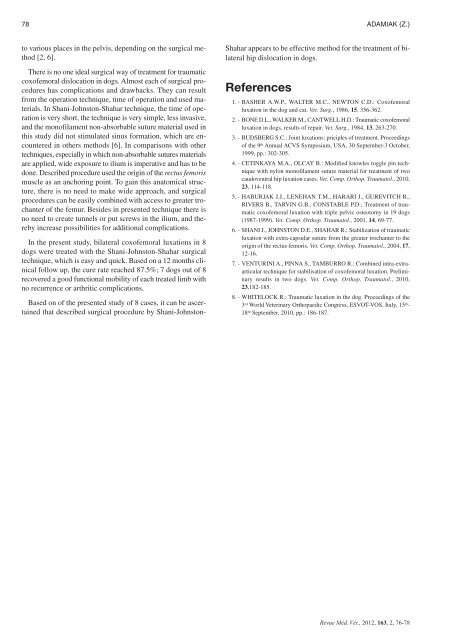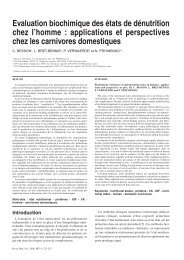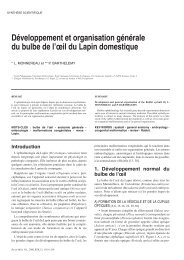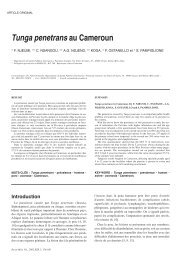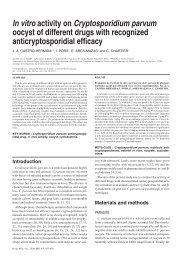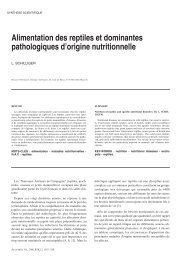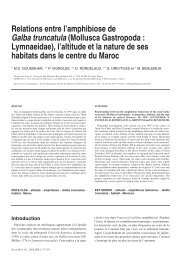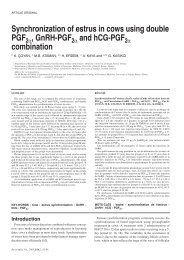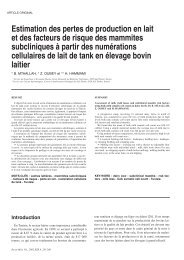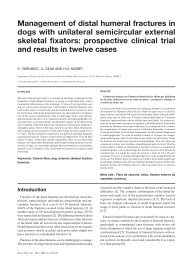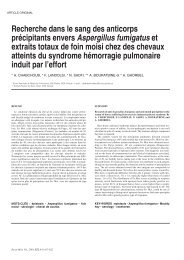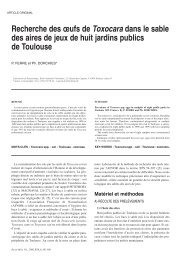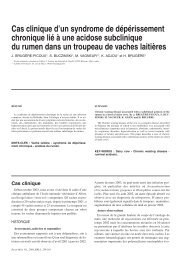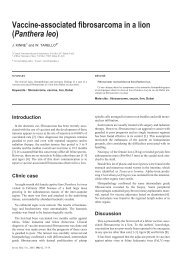Treatment of bilateral hip luxation in dogs
Treatment of bilateral hip luxation in dogs
Treatment of bilateral hip luxation in dogs
Create successful ePaper yourself
Turn your PDF publications into a flip-book with our unique Google optimized e-Paper software.
78 ADAMIAK (Z.)<br />
to various places <strong>in</strong> the pelvis, depend<strong>in</strong>g on the surgical method<br />
[2, 6].<br />
There is no one ideal surgical way <strong>of</strong> treatment for traumatic<br />
cox<strong>of</strong>emoral dislocation <strong>in</strong> <strong>dogs</strong>. Almost each <strong>of</strong> surgical procedures<br />
has complications and drawbacks. They can result<br />
from the operation technique, time <strong>of</strong> operation and used materials.<br />
In Shani-Johnston-Shahar technique, the time <strong>of</strong> operation<br />
is very short, the technique is very simple, less <strong>in</strong>vasive,<br />
and the mon<strong>of</strong>ilament non-absorbable suture material used <strong>in</strong><br />
this study did not stimulated s<strong>in</strong>us formation, which are encountered<br />
<strong>in</strong> others methods [6]. In comparisons with other<br />
techniques, especially <strong>in</strong> which non-absorbable sutures materials<br />
are applied, wide exposure to ilium is imperative and has to be<br />
done. Described procedure used the orig<strong>in</strong> <strong>of</strong> the rectus femoris<br />
muscle as an anchor<strong>in</strong>g po<strong>in</strong>t. To ga<strong>in</strong> this anatomical structure,<br />
there is no need to make wide approach, and surgical<br />
procedures can be easily comb<strong>in</strong>ed with access to greater trochanter<br />
<strong>of</strong> the femur. Besides <strong>in</strong> presented technique there is<br />
no need to create tunnels or put screws <strong>in</strong> the ilium, and thereby<br />
<strong>in</strong>crease possibilities for additional complications.<br />
In the present study, <strong>bilateral</strong> cox<strong>of</strong>emoral <strong>luxation</strong>s <strong>in</strong> 8<br />
<strong>dogs</strong> were treated with the Shani-Johnston-Shahar surgical<br />
technique, which is easy and quick. Based on a 12 months cl<strong>in</strong>ical<br />
follow up, the cure rate reached 87.5%; 7 <strong>dogs</strong> out <strong>of</strong> 8<br />
recovered a good functional mobility <strong>of</strong> each treated limb with<br />
no recurrence or arthritic complications.<br />
Based on <strong>of</strong> the presented study <strong>of</strong> 8 cases, it can be ascerta<strong>in</strong>ed<br />
that described surgical procedure by Shani-Johnston-<br />
Shahar appears to be effective method for the treatment <strong>of</strong> <strong>bilateral</strong><br />
<strong>hip</strong> dislocation <strong>in</strong> <strong>dogs</strong>.<br />
References<br />
1. - BASHER A.W.P., WALTER M.C., NEWTON C.D.: Cox<strong>of</strong>emoral<br />
<strong>luxation</strong> <strong>in</strong> the dog and cat. Vet. Surg., 1986, 15, 356-362.<br />
2. - BONE D.L., WALKER M., CANTWELL H.D.: Traumatic cox<strong>of</strong>emoral<br />
<strong>luxation</strong> <strong>in</strong> <strong>dogs</strong>, results <strong>of</strong> repair. Vet. Surg., 1984, 13, 263-270.<br />
3. - BUDSBERG S.C.: Jo<strong>in</strong>t <strong>luxation</strong>s: priciples <strong>of</strong> treatment. Proceed<strong>in</strong>gs<br />
<strong>of</strong> the 9th Annual ACVS Symposium, USA, 30 September-3 October,<br />
1999, pp.: 302-305.<br />
4. - CETINKAYA M.A., OLCAY B.: Modified knowles toggle p<strong>in</strong> technique<br />
with nylon mon<strong>of</strong>ilament suture material for treatment <strong>of</strong> two<br />
caudoventral <strong>hip</strong> <strong>luxation</strong> cases. Vet. Comp. Orthop. Traumatol., 2010,<br />
23, 114-118.<br />
5. - HABURJAK J.J., LENEHAN T.M., HARARI J., GUREVITCH R.,<br />
RIVERS B., TARVIN G.B., CONSTABLE P.D.: <strong>Treatment</strong> <strong>of</strong> traumatic<br />
cox<strong>of</strong>emoral <strong>luxation</strong> with triple pelvic osteotomy <strong>in</strong> 19 <strong>dogs</strong><br />
(1987-1999). Vet. Comp. Orthop. Traumatol., 2001, 14, 69-77.<br />
6. - SHANI J., JOHNSTON D.E., SHAHAR R.: Stabilization <strong>of</strong> traumatic<br />
<strong>luxation</strong> with extra-capsular suture from the greater trochanter to the<br />
orig<strong>in</strong> <strong>of</strong> the rectus femoris. Vet. Comp. Orthop. Traumatol., 2004, 17,<br />
12-16.<br />
7. - VENTURINI A., PINNA S., TAMBURRO R.: Comb<strong>in</strong>ed <strong>in</strong>tra-extraarticular<br />
technique for stabilisation <strong>of</strong> cox<strong>of</strong>emoral <strong>luxation</strong>. Prelim<strong>in</strong>ary<br />
results <strong>in</strong> two <strong>dogs</strong>. Vet. Comp. Orthop. Traumatol., 2010,<br />
23,182-185.<br />
8. - WHITELOCK R.: Traumatic <strong>luxation</strong> <strong>in</strong> the dog. Proceed<strong>in</strong>gs <strong>of</strong> the<br />
3rd World Veter<strong>in</strong>ary Orthopaedic Congress, ESVOT-VOS, Italy, 15th- 18th September, 2010, pp.: 186-187.<br />
Revue Méd. Vét., 2012, 163, 2, 76-78


